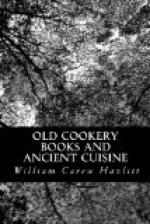The next collection of receipts, which exists in a complete and homogeneous shape, is the “Noble Book of Cookery,” of which an early MS. copy at Holkham was edited in 1882 by Mrs. Napier, but which had already been printed by Pynson in 1500, and subsequently by his successor, John Byddell. This interesting and important volume commences with a series of descriptions of certain royal and noble entertainments given on various occasions from the time of Henry IV. to that of Edward IV., and then proceeds to furnish a series of directions for the cook of a king’s or prince’s household; for, although both at the outset and the conclusion we are told that these dishes were calculated for all estates, it is abundantly obvious that they were such as never then, or very long subsequently, reached much lower than the court or the aristocracy. There is a less complete copy here of the feast at the enthronement of Archbishop Nevile. I regret that neither of the old printed copies is at present accessible. That of 1500 was formerly in the library at Bulstrode, and I was given by the late Mr. Bradshaw to understand that the same copy (no other being known) is probably at Longleat. By referring to Herbert’s “Typographical Antiquities,” anyone may see that, if his account (so far as it goes) is to be trusted, the printed copy varies from the Holkham MS. in many verbal particulars, and gives the date of Nevile’s Feast as 1465.
The compilation usually known as the “Book of St. Albans,” 1486, is, perhaps, next to the “Noble Book of Cookery,” the oldest receptacle for information on the subject in hand. The former, however, deals with cookery only in an incidental and special way. Like Arnold’s Chronicle, the St. Albans volume is a miscellany comprehending nearly all the matters that were apt to interest the few educated persons who were qualified to peruse its pages; and amid a variety of allied topics we come here across a catalogue of terms used in speaking of certain dishes of that day. The reference is to the prevailing methods of dressing and carving. A deer was said to be broken, a cony unlaced, a pheasant, partridge, or quail winged, a pigeon or a woodcock thighed, a plover minced, a mallard unbraced. They spoke of a salmon or a gurnard as chined, a sole as loined, a haddock as sided, an eel as trousoned, a pike as splatted, and a trout as gobbeted.
It must, I think, be predicated of Tusser’s “Husbandry,” of which the last edition published in the writer’s lifetime is that of 1580, that it seems rather to reproduce precepts which occur elsewhere than to supply the reader with the fruits of his own direct observation. But there are certain points in it which are curious and original. He tells the ploughman that, after confession on Shrove Tuesday, he may go and thresh the fat hen, and if he is blindfold, kill her, and then dine on fritters and pancakes. At other times, seed-cakes, wafers, and other light confections.




